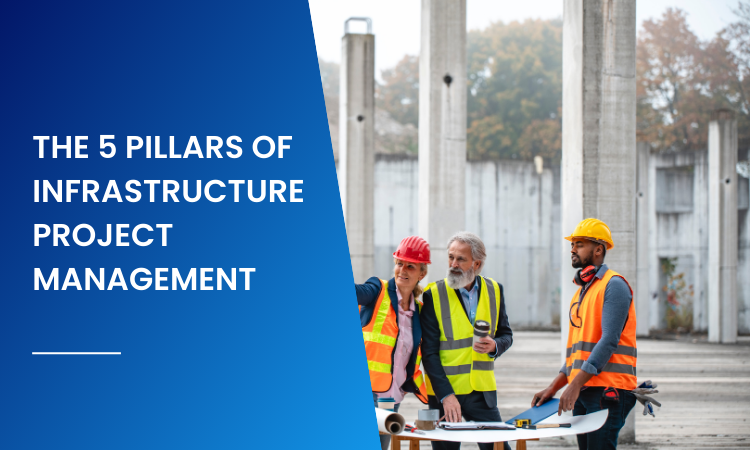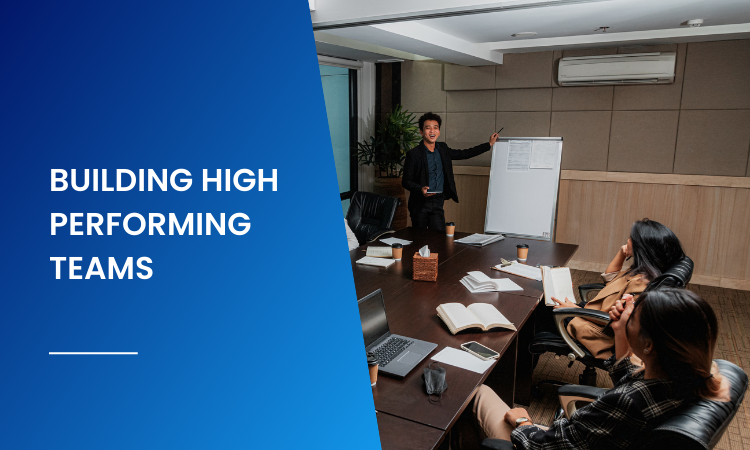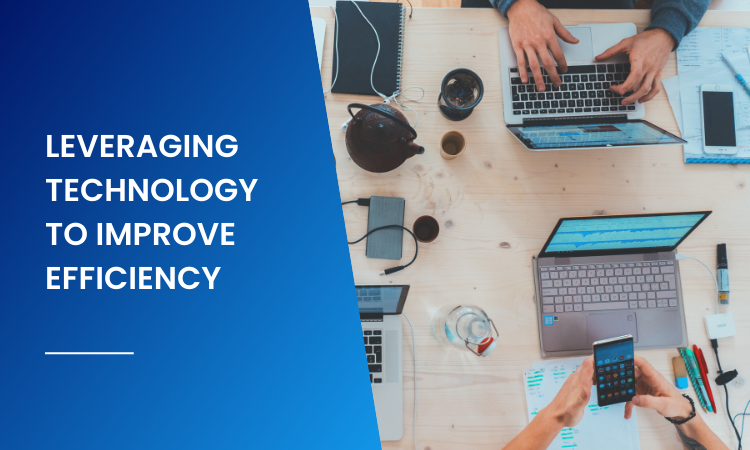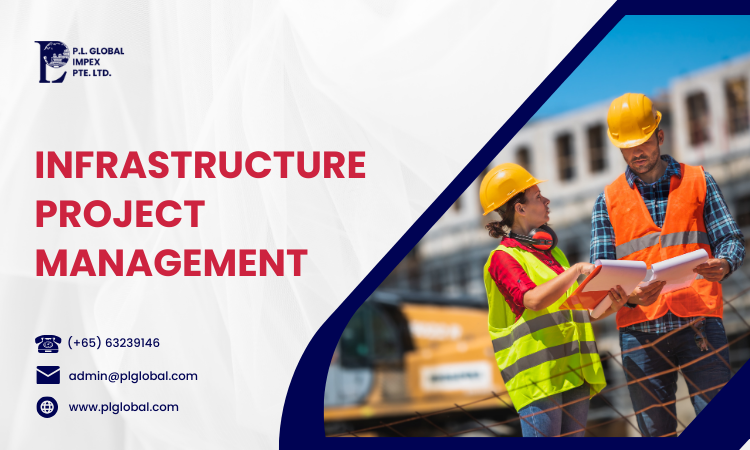Table of Contents
Introduction:
To keep our communities linked and prospering, the world depends on a robust infrastructure network that includes roads, bridges, electricity grids, and communication networks. However, the design and construction of such infrastructure is a sophisticated project management task that requires a special project manager possessing in-depth knowledge in navigating complexity, a collaborative culture, and prudent time management and cost control. This (blog) set explores the field of management of infrastructure projects in detail, and you will be more than equipped with the essential strategy and skill to transform a dream into reality.

1. The 5 Pillars of Infrastructure Project Management: Scope, Schedule, Budget, Risk, & Stakeholders:
Infrastructure development projects, from the massive highways to the complex communication networks, form the basis of our modern society. However, the design of sophisticated processes from beginning to end is crucial to their successful execution. Enter the 5 Pillars of (Infrastructure Project Management): Scope, Timeframe, Cost, Risk, and Stakeholders.
Scope: A properly defined and clearly explained project scope creates the right grounds for a good result. The scope statement describes the project deliverables, keeping the participants informed of the “what” and the “why”. The possibility of scope creep, or the unchecked expansion of project elements that can throw off budgets and schedules, is reduced with a clearly defined scope.
Schedule: In short, we can say that time is money, particularly in infrastructural works. A proper outlay schedule implies everyone is working on the same goals and will accomplish them in a set time frame. The use of project management tools like the critical path analysis helps highlight chains and areas of blockage where the trend may deviate which helps to control the progress.
Budget: Infrastructure projects frequently consist of investments on a rather large scale of money. A disciplined and controlled budget should be an important part of the plan. This covers largely the expenses that cost not only finance capital but also manpower and licensing. Instruments, such as EcoSys cost control, can perform the function of budgeting and reporting it in real time, keeping your project in check.
Risk: The unexpected is inevitable. A meaningful risk management plan should recognize the risks, evaluate their probability and outcome, as well as develop prevention factors. This forward-looking strategy lessens the chance of adversities impeding momentum in different processes.
Stakeholders: Most of the time infrastructure projects similarly reach their conclusion only being of-utilitarian in nature. The stakeholders who have an interest in the project outcome include a diverse group of stakeholders such as government agencies, community members, and many other people. Building trust, promoting consensus, and guaranteeing good running of the tasks help effective communication and collaboration with stakeholders.

2. Taming the Beast: Strategies for Managing Complexity in Infrastructure Projects:
Infrastructure projects by nature are a very complex task. It involves multiple engineering aspects with revisions always going on; multiple stakeholders with diverse interests; and uncertainty in the environment. Timelines and budgets can feel like they’re being devoured by this intricacy. Yet fear not, dear project manager! Here are some tactics to control the situation and guarantee the project’s success:
Break it Down: Divide the project into smaller, more manageable phases. This makes it possible to assign tasks more clearly, use resources more effectively, and spot potential obstacles with more ease.
Embrace Collaboration: Promote a strong team of project managers who have multi-dimensional abilities. It provides for an inclusive approach to solving problems and enables everyone to contribute and support according to his or her particular strengths.
Communication is Key: Keep all the parties involved, from engineers to community leaders, well-informed and continuously involved. It is important to have regular meetings, set clear goals, and actively talk about the issues, as this keeps the suspicions and misunderstandings at a minimum and ensures that everyone works together.
Embrace Technology: Embrace powerful (project management tools). Computerized technologies can be a useful tool in streamlining communications, monitoring progress, and identifying issues in the early stages. Moreover, EcoSys- cost management tools can be used to make sure that projects running smoothly and on budget by maintaining financial transparency.
Plan for the Unexpected: Create a very good risk management plan. Locate the possible challenges, review their possibility and effect, and then create countermeasures to them. By taking a proactive stance, you can minimize disruptions and swiftly adjust to unforeseen events.

3. Collaboration is Key: Building High-Performing Teams for Infrastructure Projects:
The quality of any infrastructure project largely depends on the performance of the team responsible for ensuring its successful completion. For example, consider intricate transportation networks composed of roads, bridges, and communication systems, and the contributions of experts in engineering, architecture, construction as well as finance can all be compared to the members of an orchestra who perform together to create a masterpiece. The symphony needs a conductor – the manager who takes the lead in collaboration and forges a team that performs at a high level.
Here are some key strategies to cultivate a collaborative environment within your infrastructure project team:
Diverse Expertise: Combine team members with different skill sets and experiences as well. Knowledgeable engineers and careful financial analysts add good signs when it is alongside business dedication. Diversity of opinion encourages problem-solving and a comprehensive approach to difficulties.
Clearly Defined Roles and Responsibilities: Every team member must grasp the work division and how each of the team members supports one another to achieve the plan. Through transparent information flow there can be fewer drawbacks from misunderstanding and it generates a more positive attitude.
Open Communication Channels: Reinforce frank and genuine exchanges between team members and stakeholders. Regular meetings, project management software, and accessible communication channels keep everyone informed and aligned.
Celebrate Successes: Encourage and appreciate team accomplishments, whether they are big or small. This strengthens the team’s bond, inspires the group, and emphasizes the importance of working together.
Embrace Technology: Tools for project management have the potential to greatly improve teamwork. Teams that are physically separated can collaborate in real-time by using video conferencing capabilities, online task management systems, and shared documents.
4. From Concept to Completion: A Step-by-Step Guide to Infrastructure Project Management:
The effectiveness of well-managed infrastructure projects is demonstrated by the surroundings. These construction projects, which range from massive bridges to complex power infrastructures, set the foundation for a flourishing community. However, a clear roadmap is necessary to guide the way from an innovative idea to a finished infrastructure project. Here’s a step-by-step guide to equip you for this exciting endeavor:
Initiation: It is a vision where all starts from. Identify the purpose of the project, conceptualize its goals, and determine the feasibility of the implementation through a study. This step also means securing project funding and getting a core team together.
Planning & Scoping: It is here that the main strategy is designed. Specify the scope of the project in an explicit manner with deliverables, timings, and resources mentioned. Implement the use of project management tools to divide the project into logical stages and discover the potential risks.
Design & Engineering: Along with the understanding of the topic, the technical points must be explained in much more detail. Engineers and architects design detailed plans and specifications upon which the project is executed are in line with safety rules and fulfill the functional needs laid down.
Procurement & Construction: Materials are purchased, contracts are put in place, and the first brick is laid. It is the most detailed phase of the project execution that requires precise management in order to make sure that tasks are done on time, within budget limits, and with appropriate quality standards.
Monitoring & Control: It is not enough to only make plans, you have to adapt too. It is important to carry out project monitoring, and expense tracking with a cost management tool, and identify any deviation from the plan. Adjustments made proactively guarantee that the project stays on course and prevents expensive delays.
Commissioning & Handover: Now the project is almost finished! This milestone encompasses the performance of tests, evaluation, and checking that the infrastructure fully satisfies all performance standards. Once satisfied, the project is officially handed over to the client.
Project Closeout: The final act! Write down the lessons learned, evaluate the project according to the initial goals, and formalize the end of the project. Hence, this may pave the way for future successful infrastructure projects, that build on the lessons learned.

5. Budgeting for Success: Cost Control Strategies for Infrastructure Projects:
Infrastructure projects, which is the backbone of our society, sometimes require considerable investments. For these projects to succeed, staying within budget is essential, and a well-defined cost control strategy is your secret weapon.
Thorough Planning & Estimating: A successful cost control strategy begins with careful preparation. Create a thorough project budget that takes into consideration all possible expenses, including labor, materials, permits, and continuing maintenance.
Embrace Technology: Integrate a project management software, which has a built-in budgeting functionality. These tools reduce cost tracking, introduce issues that lead to overruns, and enable the undertaking of budget adjustments in time.
Value Engineering: Keep on reviewing project plans and specifications to realize a chance for cost control without quality or functionality deterioration. Significant cost reductions can be achieved by this cooperative approach that involves engineers, project managers, and possibly vendors.
Procurement Strategies: Strike the best deals with suppliers and contractors. Take into account substitute materials or building techniques that provide similar quality at less expensive prices.
Proactive Risk Management: Your budget may suffer greatly from unforeseen circumstances. Early on, identify any hazards, evaluate the financial impact, and create mitigation plans. The financial impact of unanticipated events is reduced by using this proactive strategy.

6. Building Smart: Leveraging Technology to Improve Efficiency in Infrastructure Projects:
Infrastructure is what is continuously in a form of evolution, and so are the resources and tools incorporated into the toolbox of project managers. The existence of the digital era has no other choice than to continue embracing technology to remain competitive. With the use of advanced solutions, the project managers will be capable of optimizing the project performance, which brings about a faster time of completion, reduced costs, and also a better process flow.
Here’s how technology can revolutionize infrastructure project management:
Project Management Software: Such user-friendly platforms simplify interaction, job delegation, and resource planning, respectively. Live dashboards that generate concise interactive views of project metrics enable proactive changes that lead to better operational and planning decisions.
Building Information Modeling (BIM): BIM software can generate smart 3D models of the designed infrastructure project, which permits the checking of spatial conflicts, virtual walkthroughs, and better communication between disciplines. This will avoid expensive fault lines before the construction phase is over.
Drone Technology: The use of drones for aerial views of the project site provides an excellent means of keeping track of the overall project progress and surveying large tracts of land. Also, hard-to-reach areas can be inspected by an expert. This simply means that communication will be done faster and safety will guaranteed for all on the field.
Cloud-Based Collaboration: (Cloud storage organizations) provide models for secure, actual-time access to the project documents, drawings, and design details. This creates a team in which they can quickly collaborate without having to worry about version control issues regardless of where they are located.
Cost Management Tools: Integration with project management systems through software like EcoSys cost management makes all cost control processes like tracking, budget forecasting, and scenario planning possible. It enables project managers to use their financial skills effectively and control costs so that the budget is not exceeded.
7. Risk Management for Infrastructure Projects: Identifying, Assessing, and Mitigating Threats:
Completing an infrastructure project successfully is rarely an easy journey. Unexpected events, such as bad weather, and materials shortages, pose a risk to project budgets, and timelines and can even threaten worker’s safety. This is the point where risk management steps in and provides the focal point. The risk management functionality is a core project manager competence. This allows the manager to sense possible threats, and their impact, and to develop strategies to avoid those obstacles ahead of time.
Here’s a breakdown of the key steps in risk management for infrastructure projects:
Risk Identification: Discuss any possible threats with your team. Think about anything from labor disputes and permitting challenges to weather delays and swings in material costs. The risk is not always too small for consideration.
Risk Assessment: Now that you have made these risks known, organize them in order of the probability of their occurrence and the possible scale of the project being affected. A high probability of high-impact risk needs a stronger mitigation plan.
Risk Mitigation: Policies should be devised to address risks that have been identified. Such an approach could be established through the development of backup plans, contracting with different suppliers, or procuring insurance coverage. Regarding financial risks, you can utilize a cost management tool for real-time adjustments to your budget.
Risk Monitoring & Control: It is not enough to just plan but to monitor as well. Assessing risk periodically during the project lifecycle is an integral component. Outline new risks, analyze the availability of pre-existing mitigation plans, and adjust the strategy dynamically.
8. The Networked Project Manager: Building Strong Relationships with Stakeholders in Infrastructure Projects:
Infrastructure projects are complex and involve many different elements: technical skills, financial resources, and the involvement of a group of people with different roles. These stakeholders, which range from government organizations and local authorities to engineers and financiers, have a stake in the project’s success. This is where the “Network Project Manager” steps in.
In addition to being a team leader, a network project manager is an adept relationship builder. Here’s how building trusting connections with stakeholders contributes to the success of infrastructure projects:
Open Communication & Transparency: Posting timely updates, assigning clear channels of communication, and addressing issues would make a lot of difference. Keep your stakeholders informed, listen to them to understand their views, and promote open participation.
Understanding Needs & Priorities: Stakeholders come from different walks of life and persuasions. Spend enough time to get under their skin, with their perspective and concerns. Through this, it is promoted that a common goal be achievable. This is a process that is jointly run.
Managing Expectations: In establishing realistic objectives for project durations, funds, and predicted effects. Effective communication is a proactive and preventative measure that avoids misunderstandings and cultivates a common sense of commitment to the project.
Building Trust & Advocacy: Project managers gain trust by acting with skill, integrity, and a dedication to stakeholder involvement. Stakeholder advocacy, or advancing the initiative within their networks and communities, is a result of this trust.
9. Case Study: How EcoSys Cost Management Helped a Major Infrastructure Project Stay on Budget:
Visualize a large highway project – a key infrastructure that serves as the medium that connects all the communities and helps economic growth at the same time. This ambitious project, however, faced a significant challenge: staying close to the budget. Whether it was a disruption in cost control, unanticipated delays, or agreements between complex subcontractors, any of these issues would have led to the derailing of the project’s financial trajectory.
Enter EcoSys Cost Management. This effective software solution was built into the project management system in order to obtain the current picture of the project finances in real time.
Centralized Cost Tracking: EcoSys created a single, user-friendly platform that combined cost information from multiple sources, such as labor expenses, material purchases, and invoices from subcontractors. As a result, data silos were removed and the whole project cost was clearly visible.
Real-time Budget Monitoring: EcoSys had precise real-time feedback on their budget variances. The project managers could detect in just a moment the areas where spending exceeded the original estimates and thus provide for instant corrective action to fix the problem.
Scenario Planning & Cost Control: The software’s scenario planning capabilities allowed the team to model the impact of potential cost changes, such as material price increases or delays. Their proactive strategy assisted them in creating backup plans and making wise financial choices.
Improved Communication & Collaboration: Transparency was encouraged in EcologySys by posting up-to-date cost data in front of all stakeholders. This led to more substantial conversations which enabled all voices to be heard as the community worked collaboratively to recognize areas of savings.

10. The Future of Infrastructure Project Management: Trends and Innovations to Watch:
The infrastructure projects management world is getting ready to witness a thrilling evolution. Since the advent of new technology and changing societal needs, innovative and future trends will reshape the way of the planning, building, and operation of the infrastructure of tomorrow to a new level. Here are a few key areas to watch:
Rise of Big Data & Analytics: Projects involving infrastructure produce enormous volumes of data. We will use this data to our advantage by using advanced analytics tools to plan projects more effectively, foresee possible problems, and pinpoint areas where we can save costs.
Integration of Artificial Intelligence (AI): Adopting AI in infrastructure management can automate routine tasks, enhance the decision-making process, and make the best use of scarce resources. Consider instruments with AI capabilities that recommend materials that save money or anticipate delays.
The Continued Evolution of BIM: BIM (Building Information Modeling) will grow to the level of complexity that makes it possible to integrate time (4D) and cost (5D) into it. It will be possible for project managers to develop time and cost dimensions considering the BIM model, which will result in better comprehension of the project.
Focus on Sustainability: With the environmental issues being in the driving seat, the sustainability of the infrastructure projects will be of uppermost importance. Look forward to the development of the next generation of green building materials, renewable energy integration, and life-cycle costing instruments that account for the environmental costs in the design stage.
The Evolving Role of Project Managers: The future manager of the project will hold the title of a data-empowered leader, proficient in deploying the technology to make insightful decisions. Project managers will continue to need strong collaboration and communication skills to traverse an ever-more complicated ecosystem of stakeholders and technologies.
Conclusion:
Recognizing the indispensable role good governance of infrastructure project management plays, one can ensure that these projects turn into the foundation for sustainable development and a vigorous future. Bear in mind that building relationships with other project managers and cost (management) toolsets are the keys to your successful projects. Thus your journey to an advanced understanding of infrastructure project management continues as we walk with you step by step by not only teaching you how to build road and wildlife crossing bridges but also to bridge you on the path to success.



